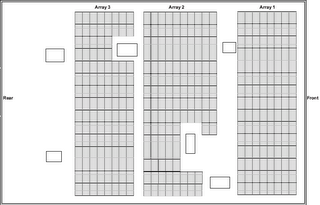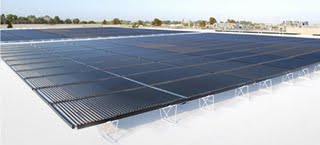photovoltaic
Advantage Laser Installs 21.8KW Solyndra Solar Array
Next week we begin installation of rooftop solar array on our MICR toner cartridge manufacturing facility in Atlanta, Georgia. The solar project has been broken into three arrays. We will start by installing Array #1 – a 21.8KW array that will produce 29,654 KW hours per year. This will only provide about 23% of the power we currently use. Once Arrays #2 and #3 are built the complete system will provide 70% of our power usage. Our goal will be to become power neutral meaning we produce 100% of the power we need. So after all 3 arrays are installed, we will have to decrease our power usage by 30% via increased efficiency e.g. LED lighting project (more on that later).
It Makes Environmental and Business Sense
The environmental benefits of solar power are obvious, the challenge is to operate as green as possible and still remain a viable business. I looked at solar a couple of years ago, but it was difficult to make the numbers work. The federal government was giving a 30% tax credit and the state (Georgia) had no incentive whatsoever. Several months ago Mark Bell with Empower contacted us about solar. He got us up to date on solar power legislation and incentives. Solar (green) power was included in the economic stimulus and recovery act of 2009. Now the federal government will pay the 30% as a grant up front and the state of Georgia will give an additional 35% tax credit towards a commercial solar installation. This made all the difference. The federal grant, means we don’t have to borrow as much money. The state also has a grant, but it is limited to $2.5 million and applications flooded the GEFA office. The rebate program was closed after just one day. So we’re going the tax credit route, which creates a challenge in itself. Sometimes I think the tax aspects of a solar array are much more complex than the technical ones. After calls to two accountants, the state and Empower, we determined the array would pay for itself in about five and a half years. Not bad, after that we’ll have an array with a 25 year life expectancy with free green power.
Solar Panels Made in the USA

Much of the solar PV (PhotoVoltaic) is dominated by China these days. We prefer to buy products made here in the USA when we can. Lucky for us, we have a white roof. Why should this matter? This allowed us to install a new innovative solar panel from Solyndra (made in Silicon Valley CA). Traditional PV uses a solid panel that is angled to the sun to maximize efficiency. But angled panel makes a great sail and therefore it requires a physical attachment and penetration through the roofing system or a heavy ballasting system.

Solyndra has a revolutionary solar panel that uses a series of tubes with space between them so that the wind passes right through them. The tubes on the Solyndra panel absorb the sunlight that is reflected off the white roof as well. The result is an array that can be installed in a fraction of the time and maximizes efficiency per square foot. The Solyndra panel costs about twice as much as a traditional panel, but the savings in installation time and mounting brackets make them come out about even. We are one of the first Solyndra customers in the Southeast for a technology that may revolutionize solar installations on many flat-roofed buildings.
Below is our rooftop layout of all 3 arrays. Array #1, on the far right, will be the first. Installation of all three was too much of a financial burden. Our goal is to install an array each year for the next 3 years.

Once Arrays 2 & 3 are complete, our system power will be a total of 65.9 KW producing 85,865 KW hours a year.
Selling Green Power vs. Decreasing Peak Load
As we harvest energy from the sun there are several ways to take advantage of it. One is to use the power ourselves with net metering. With net metering our meter “run backwards” when we’re producing more energy than we’re using. Otherwise it just slows down our meter. An advantage of net metering is we can use the solar array to decrease our peak load. Commercial customers are charged per KWH, but GA Power has incentives to business to smooth out their power usages by charging more, the higher your peak load. Each month a commercial business peak load rate is determined by the highest half hour power usage in the previous 11 months. The business about calculating peak load appears to be intentionally designed to be confusing. Empower has been working with us to see if they can decrease our peak load, and thus lower our overall price we pay per KWH.
Another option we have is to sell our “green” power to GA power through their Green energy buyback program. In this program, we take 100% of our green power and sell it to GA Power for $0.18 per KWH (about 4-5 cents per KWH than we pay for solar power). Right now GA Power’s green energy buyback is closed to new energy providers. The program is capped 1.5 Megawatts per year, which isn’t that much.
Increasing Efficiency
We are investigating a LED lighting project that would replace all of our existing florescent lights with new LED fixtures. Initial estimates indicate we would save about 15KW with the LED project. Empower is also consulting with us on the LED lighting project as well.
We are also replacing the largest two of our four HVAC units with new Trane High Efficiency units. We’ve also added rooftop motion detection and surveillance cameras. This will double to protect our solar array as well as our HVAC units from copper theft.
Installing a solar array has some exciting possibilities, but before you take the plunge, do the research. There is a lot to learn, especially about the tax code and what you can deduct and what you can’t. But in the end, if you have a long term perspective, investing in a solar array makes sense. Imagine the energy savings and decrease in air pollution that would be possible if every business with a roof filled them with solar panels.
I’ll be posting pictures of the array installation as I can. -Marvin Masson

